Games
PCB
Archive
Chip
Archive
Cart/Box
Scans
Articles
Peripherals
Prototypes
Unreleased
Games
Rarities
Homebrew
Emulation
Links
Email: snes_central@yahoo.ca
TinheadTinhead |
 Tinhead was an unreleased game, intended for a 1994 release. It was cancelled after developer MicroProse ran out of money. A completed ROM image of the game exists, and it was released commercially in the US on the Genesis. By:
Evan G
|
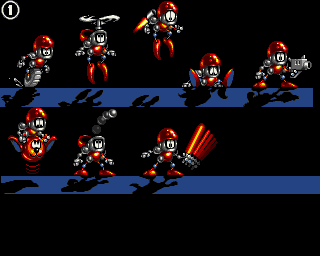
Tinhead was one of the many action platform games planned for release on 16-bit systems. The game was in production at the UK development studio, MicroProse. Unlike Boo!, a game in development at about the same time as Tinhead, this game was completed. It was in development for the SNES, Genesis and Amiga. The Genesis version was released in the US by Accolade and Spectrum Holobyte, though remained unreleased on the SNES for unknown reasons. According to game producer Stuart Whyte, the Amiga version was in development but never finished (Stuart Whyte is the current executive producer at Lionhead studios, responsible for the Fable series). The game was never released by MicroProse due to the game maker running out of money. A working title for this game was Waldo.
ROM Image
A ROM image of the unreleased SNES version of Tinhead exists, though its source is unknown. If I were to guess, this game was leaked out onto USENET during the 90s. Another possibility is that the ROM image came directly from Stuart Whyte's website, though considering the .smc extension, I would bet against that. Also, the ROM image is PAL, so if you try playing this in a flash cart on an NTSC SNES (which is all the rage now a days), the game will run too fast. Aside from the extra speed, I did not notice any glitches when I played it on my NTSC SNES. Believe me when I say this will hamper any efforts to pass this game. The game itself appears to be finished.
The Game
Tinhead was complete, but I have to rank this as a second rate platformer, among the Zools, Bubsys and Aero The Acrobats of the 16-bit platforming realm (though Aero the Acrobat 2 is freaking awesome). With the glut of platformers out there, surely this game would have been buried among them. Perhaps the competition on the Genesis was less, making it justifiable for release on that platform. Whatever the reason it was not released on the SNES, we may never know.
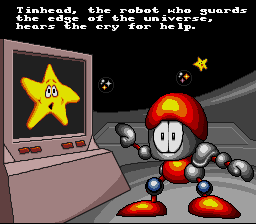
The story behind Tinhead is some intergalactic goblin, known as Grim Squidge, has stolen all of the stars in the galaxy by sucking them up in his vacuum cart and scattering them elsewhere. Tinhead, the protector who guards the edge of the galaxy gets a distress signal and goes to rescue the stars. Not exactly an inspiring story, but then again, what platformer from the early 90s had one?
The game is a platformer, with a strong shooter aspect to it. The game has more in common with Super Mario than Contra, though. There are four levels in the game, each broken up into three "sectors", and further split up into two sub-sectors. This means each level has six parts. After each sector, you get a password to save your progress. At the end of each level, there is an end boss. This game is a collect-o-thon, though the main things to look for are batteries (which increase Tinhead's health) and tin balls (which increase the amount of shots you can fire simultaneously). One annoying aspect is that the orange capsules that contain the powerups must be touched before the powerup can be collected. In tight spots, this can require making a tricky jump twice if you need the powerup.
Tinhead is a cute looking platformer with nice (if simple) graphics. There isn't a lot of variety in the levels, with only five or six enemy types per stage. The level graphics are basic, sort of reminiscent of the original Sonic the Hedgehog. The graphics are very colourful and smooth, and would have appealed to the demographics of those who played video games at the time. There is nothing that makes it stand out from other 16-bit platformers, though.
I really liked the music in this game, but after listening to the same tune for six straight stages, it gets old. In particular, I liked the music from the second level, which starts off nice and cheery, then gets manic. Having more variety would help the game go by easier, as deaths and level restarts are rampant. The sound effects are generic blips and bloops.
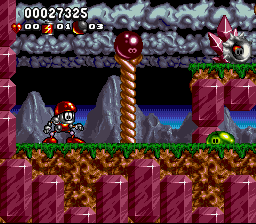
As for gameplay, the controls work well. It suffers from what I refer to as "Mega Man Collection Gamecube Syndrome", where the jump button is mapped to the "Y" button rather than the "B" button like virtually every other platform game released on the SNES. Luckily, the designers have four different button configurations, so you are not stuck with the default scheme. There are three different shot types: fully horizontal, shot upwards at a 45 degree angle, and lobbed to bounce around on the ground. Each shot type is mapped to its own button. If you use control style "3", the horizontal shot is mapped to the Y button, which is likely optimal for most gamers. The game limits the amount of shots you can fire simultaneously until you gather powerups to increase your capacity, which can lead to slow progress. Jumping is done without difficulty, though if you hit a ceiling while jumping, you lose all your momentum. Realistic, maybe, but it is downright frustrating in parts.
Lessons In Platform Game Level Design
The part of the game that makes it sub-par is not the simplistic graphics or repetitive music: the level design is very poor. A lot of the problems likely would be resolved if the view wasn't so narrow. At any rate, here are eight rules of designing platform games.
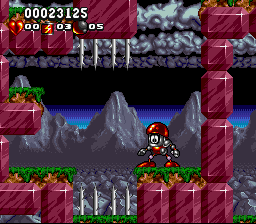 |
Rule 1: When making a platform game, never put in a spot where you have to make a jump that is pretty much impossible to achieve without getting hit. The example above shows a point in the first part of the third sector in level one where you have to get through this gap that has spikes above and below you. Jump too high, and you get a spikes to the head, and you will most likely miss the platform as your momentum gets killed. Jump too low, and you miss the platform and get hit by the spikes from below. It is lose-lose all around unless you get very lucky (after probably 20 attempts, I still couldn't do it).
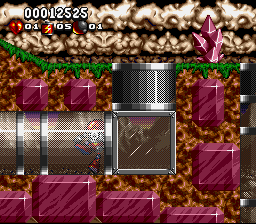 |
Rule 2: When making a platform game, never force the player to go back to the start of the level unnecessarily. In level one, there are various chutes that transport you to different parts of the stage. However, there is little indication to suggest whether or not the chutes will progress you through the level or send you backwards. In one stage, I was about halfway through, and went through one of these chutes, and I was sent to start of the stage. I would have been just as well off to have perished!
Rule 3: On a similar note, when making a platform game with very large levels, it is always a good idea to have midpoint saves so that when you die, you don't have to restart from the beginning of the level! The stages in this game are incredibly long, which is not a bad thing on its own, but if you are near the end of the level and you die, you have to start over again. I found myself dying a lot, so this made the game much more frustrating than it would have otherwise been. There really isn't any excuse for it, considering that the concept of the midway save point has been around since Super Mario Bros. for the NES (and the levels in that game are much shorter than the ones in this game).
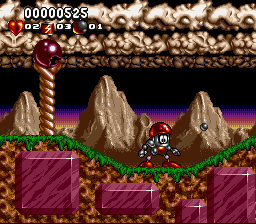 | 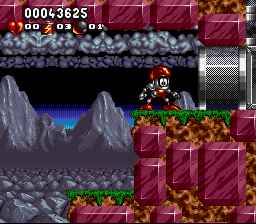 |
| Beginning of Level 1, Sector 1, Stage 1 | End of Level 1, Sector 3, Stage 2 |
Rule 4: Variety is the spice of life, so they say, and there isn't much of it in this game. The graphics in all six stages for the levels do not change. The simple graphics are fine, but after seeing the same scenery and listening to the same level music for six stages, it gets pretty old. When designing a platform game, change things up every couple of levels or so!
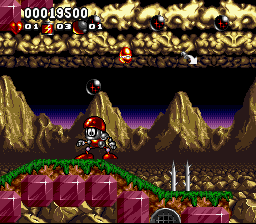 | 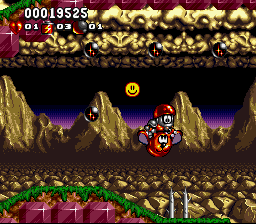 |
| Ooo, a bouncy ball powerup! | Aaaarg! Spikes! |
Rule 5: When making a platform game, do not place a powerup directly over a bunch of spikes that you can't avoid because you fall straight down after getting the powerup. I never was able to get the powerup above without getting hit.
 |
Rule 6: When making a platform game where you have things like fans that blow you to great heights, there are a couple of rules. Number 1: If there are spikes to avoid, make sure they are visible before jumping on the fan! In the example above, there are three fans, with two that are directly underneath spikes of death that you cannot see at fan level. Number 2: Ensure that the fan blows you to where you need to go. The screen above shows me in a position where I am completely stuck. The fan doesn't blow me up to the platform I need to get to, nor is there any way to go down. This is essentially forces you to hit restart. Mind you, it is a pretty uncommon occurrence to be in this position, but it happened to me more than once in this spot. Terrible, but perhaps an indication that this game was not 100% finished.
 |  |
| The horrors of attacking enemies on a hill | Try beating this enemy without getting hit |
Rule 7: You know, I love slopes. I thought that the slopes in Super Mario Bros. 3 were a real treat and made for some interesting levels. Tinhead uses slopes, but makes them so that they seem like they are covered in some sort of low viscosity fluid. You slide down these hills rapidly, and for whatever reason, you walk up them just as fast. This makes fighting enemies on slopes, or at the bottom of slopes nearly impossible without taking damage. When designing a platform game, don't make the character slide down slopes too fast!
Rule 8: The last point I would like to make on level design is what I call "the unseen threat". In Super Mario World, you could press L and R to scroll the screen to the left or right to get a view of what was ahead, though it was not entirely necessary as you could always see threats as they came. In Tinhead, you can also do this, but you soon find that it becomes a necessity to constantly hold down the scroll button. The level graphics are nice and large in this game, but the zoomed-in view serves as a handicap when it comes to the actual gameplay. If you play this game, you will run into many points where you make a jump to a new platform, and immediately run into an enemy that takes more than one hit to kill, giving you no recourse but to take a hit. Sure, there are tons of health powerups in this game, but the real problem is that you lose one of your simultaneous shots every time you get hit. This makes it a slow affair to tackle parts of the level not yet explored. Not only that, but there are many points where you must make a leap of faith, and when falling not know what is below (often there are spikes and enemies!). When designing a platform game, make sure that the player can see enemies and other dangers before making a leap!
Comparison with the Genesis version
 | 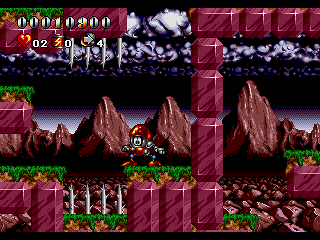 |
| Unreleased SNES version | Released Genesis version |
The Genesis version of Tinhead is pretty much exactly the same as the Super NES version. Some of the powerup graphics are different (for example the star you need to collect before you can complete a level). The sound in the Genesis is inferior to the SNES version. In particular, the sound effects and music sound tinny compared to the SNES version. The controls are much different than the SNES version due to the lower amount of buttons on a standard Genesis controller. There are no buttons for manual scrolling of the screen. Also, there is only one button for shooting: to switch between the different types of shots you have to press the A button. The game also plays fast, almost as if they didn't bother to optimize it for a NTSC console. Due to the wider resolution of the Genesis, there are somewhat fewer problems with "the unseen threat". As you can see from the screenshot comparison, the problems with level layout still exist. Which version of this game you play is a matter of preference, I suppose.
| Genesis cart (thanks to Eric Dude for the picture) |
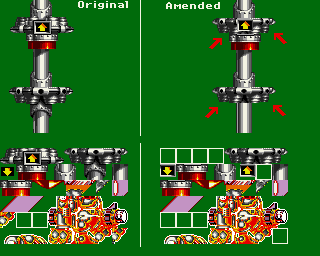
Developer's goodies
On Stuart Whyte's webpage on Tinhead, there is a zip file full of raw graphics used during the development of the game. I converted these graphics from Amiga bitmap to PNG for your viewing pleasure (see the screenshots section). The graphics appear to come from both the SNES and Genesis versions of the game. I can't comment on the amount of unused tiles for the game, but as you can see from the image on the right, there are instances of graphical changes during the development of the game. There are many images that are identical, but have different pallets. There also are several images showing different models for the Tinhead character itself.
Another interesting developer bit is this document on sound design. This particular document is for the Mega Drive version of the game (I would assume the game was in development for the Mega Drive/Genesis before porting to the SNES). It is interesting because it gives insight on how music and sound effects were planned for the game. Things of interest include the fact that this game was designed for the PAL version first, with compensation to make sure the sound effects do not go too far out of sync in the NTSC conversion. As an example of how the sound was designed, here is a description of the first level music:
The Level One music should be a fast paced, cheerful tune, in a similar style to the main theme music (hardcore rave meets Kylie Minogue) but with a different tune and without the cartoon sound effects. Emphasis should be placed on conveying a sense of urgency, and there should perhaps be echoes of 'chase scene' music. The piece of music should be two minutes long, and should loop.
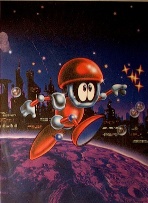 |
| Render used for MicroProse's 1993 Christmas cards |
Codes
There are several codes for the game. All are taken off Stuart Whyte's page.
- Level 1-2 - LAMBDA
- Level 1-3 - SARTRE
- Level 2-1 - QUANTA
- Level 2-2 - MESONS
- Level 2-3 - TENSOR
- Level 3-1 - LEPTON
- Level 3-2 - GORGON
- Level 3-3 - BOSONS
- Level 4-1 - BARYON
- Level 4-2 - GIBSON
- Level 4-3 - NEUMAN
- BALROG - password to send you to the final boss, I assume
- CAMELS - The only thing I could see affected by this code is that it sets your shots to max, and that your shots don't decrease when you get hit.
Summary
Tinhead, whether on the released Genesis version or the unreleased Super NES version, is a sub-par platform game. I found it to be very frustrating, and I never even bothered attempting to get past the second level. In fact, at times I wished I was playing Batman: Revenge of the Joker! The graphics and sounds in this game are nice, but the poor level design and zoomed in playing field drove me nuts. With the plethora of platform games available on the Super NES, this game would have been lost in the shuffle to far superior games in the genre. The game's brutal difficulty makes this one a hardcore-only affair. It is really no wonder no publisher bothered to pick this game up for the SNES.
Screenshots
Screenshots (119)Scans
Bibliography
- Review of the Genesis version of Tinhead on Sega 16 (link)
- Page on Tinhead by producer Stuart Whyte (link)